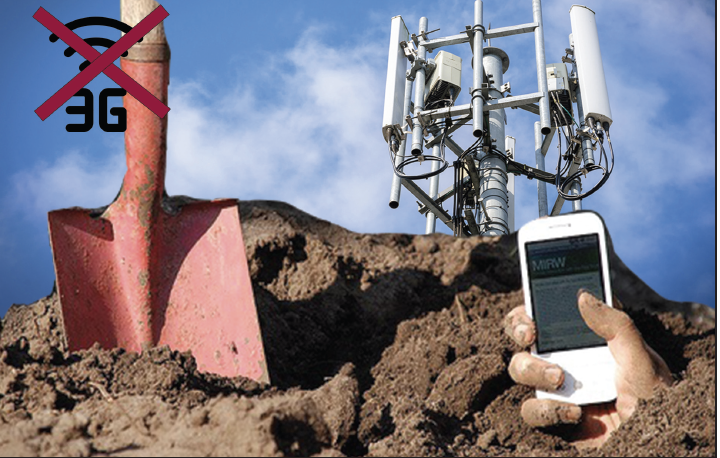By Tammy Curtis, Managing Editor
On Feb. 22, the era of 3G ended forever. Locally, this brought many out to cell phone stores in the area with questions about why data and voice features on their aging phones no longer worked properly.
Most American’s are aware we live in an every changing technology driven world. Replacements and upgrades for electronic devices that are the fastest and best today are already being developed. Cell phone and devices relying on Internet technology have undergone massive changes in the last 10-15 years and on Feb. 22 the best example of late breaking technology in 2009 began being phased out when AT& T was the first of the cellular providers to pull the plug on 3G service.
3G was once the highest standard for cellular internet, but it’s long been replaced, first by 4G LTE, and now by 5G.
On Feb. 22, the era of 3G ended forever. Locally, this brought many out to cell phone stores in the area with questions about why data and voice features on their aging phones no longer worked properly.
Living in a retirement area in Sharp, Fulton and Izard Counties, with a larger than normal retired population, many of who only use cell phones for their original purpose, and own devices like Kindles, fall detectors, home security and vehicles equipped with 3G mapping and support devices, it is easy to see how the 3G shutdown could cause many problems and questions.
A tech support person at Twomey Computer in Highland said he had several customers come in who were unaware of the change. Many have had the same cell phones for years and have finally become comfortable with them and do not like change. But unfortunately, change is the driving force of most technology driven devices. Cell phones, are certainly not the only devices affected as 3G is being phased out. Sprint and T-Mobile devices will end 3G connectivity on April 1 and Verizon by Dec. 31.
What products will be impacted?
The shutdown will impact people still using 3G Kindles, 3G flip phones, the iPhone 5 and older models as well as various Android phones. It will also affect home alarm systems and medical devices such as fall detectors. Some in-car crash notification and roadside assistance systems like OnStar will need to be updated or replaced, too.
If you’re not sure which network your phone is on, open Settings, tap Network and Internet, and then select Mobile Network on Android devices. On iOS, choose Settings, Cellular and then pick Cellular Data Options. AT&T also has a dedicated webpage to determine if your device will be impacted by the shut down.
It can be harder to tell with other everyday products. If you’re not sure whether the device relies on 3G, you can call the manufacturer or car dealer.
How Will Phones be Affected?
Any phone that is not capable of either 4G LTE or 5G connection will see its cellular service suspended. This includes internet data, texting, voice calling, as well as 911 calls. However, many phones manufactured in the 2010s are compatible with both 3G and 4G services and will still be able to access 4G after the shutdown. Some 4G connected phones still rely on 3G signal for voice calls, so if your phone isn’t “HD Voice” (high-definition voice calling) compatible, it could lose the ability to make calls once 3G service is disconnected. Some models will allow HD Voice to be enabled via software update.If the device features Wi-Fi connectivity, it will still be able to access the web and stream content through a wireless router even if it can’t send calls or texts via cellular connection. If you’re unsure whether your phone model will be affected, contact your carrier for more details. They may even offer discount deals for those who switch from old model devices.
What are some solutions for phone users who may not be able to afford a new 5g phone?
AT&T has said in multiple news releases that it has been proactive in contacting customers since last year about the transition in various forms. They have provided and continue to provide free phones. The company is providing AT&T Radiant Core phones free. They have also provided a webpage for customers to check their phone models to see if they are affected and need replaced as well as tests to determine the type of software. It can be accessed at https://www.att.com/support/article/wireless/KM1070617/. A link will also be placed on our website at src-news.com.
How Will Other
Devices be Affected?
Any other devices, such as navigation systems, that are 3G only will lose certain functionality. They will still be able to turn on and any process that does not require a network will still be able to be performed, but things like updates will not be available. For example, a Sat-Nav will not be able to show live traffic reports. Devices which use a 3G SIM card for live information will lose some or all online functionality, although some may have firmware updates available to alleviate the problem.
According to Consumer Reports, many older vehicle models have emergency contact features which can use a 3G signal to automatically alert rescue and medical personnel in the event of a crash. The website mentions that cars from Chrysler, Dodge, Hyundai, Jeep, Lexus, Nissan, Ram and Toyota are affected, some as recently as the 2021 model year:
• Nissan, Infiniti, Toyota and Lexus vehicles before 2019 will lose crash alert features, with no current plan for an update.
• Some Honda models will require console hardware to be upgraded at cost.
• General Motors vehicles will retain functionality after a software update, which should happen automatically.
• Fiat-Chrysler models can be upgraded to 4G with a $10 per month data plan. However, automatic crash alerts will be discontinued.
• Some Hyundai, Genesis, and BMW vehicles will be eligible for a free update.
Home security and alarm installations are another major use case for 3G. A report from Axios says as many as 2 million fire and burglar alarms in the United States rely on 3G services to alert authorities. The industry is trying to keep up with the demand for updates, but chip supply issues and the ongoing Covid-19 pandemic have slowed the process. If your home uses a wireless security system, contact the installation company for more information and possible update plans.
What is 3G, 4G LTE and 5G
3G is simply the standards of third generation wireless broadband that was agreed upon at the time by the cellular industry. This was based on a minimum data speed of 144 kilobytes per second, the highest available in the early 2000s, years before the smart phone and application based era began. This era demanded faster internet speeds for phones to perform even the most common of functions.
As applications grew, and phones evolved from a simple communication device into an entire office, computer, phone and any other item an application could provide. Economic prices and features brought on more users and with that came the need for more speed. While watching high resolution videos or streaming entire television shows was unheard of on a phone prior to smartphones, with 4G LTE that too became a reality around 2008. With 4G LTE, customers could get up to 100 megabytes (not kilobytes ) per second download speeds and with a longer range.
As the numbers increased, so too did the need for yet faster Internet capabilities. 5G was born a few years ago and cellular providers have raced to stay at the top of the line in providing their customers with the fastest speeds possible. In doing so, the number of 3G customers have drastically dwindled, making the cost to keep up the transmission of the 3G networks for the few users, costly. Statements on various news sites from AT&T and Verizon state that less than one percent of their customers are on 3G.
With 5G, the speed increased exponentially to 20 gigabytes (not megabytes) per second to keep up with the demanding tasks the network now requires for cellular users. The issue with 5g is the service requires more transmitters than ever before. By eliminating 3g, the networks free up cellular spectrum and it helps to prevent clashes with the older technology.

